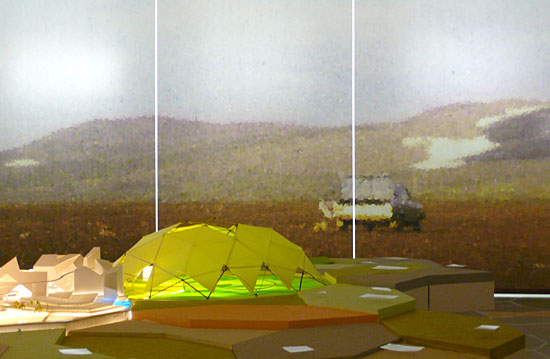The Icelandic Oasis
Einar Thorsteinn's geometric proposition for a green community in the center of Iceland
curated by Simon Irgens, in collaboration with architecture students from Prof. Wolfram Popp and Sven Pfeiffer's studio at the Technische Universität Berlin
June 14 – July 14, 2007

Though the way we live continues to change, the places we live in have become fixed to forms and ideals that were determined by past generations. Traditionally, cities have grown and developed along physical information and transportation networks like roads and rivers. The shape, form and location of our settlements are often determined by these systems.
Today, as information moves increasingly along electronic networks,the constraints and determinants of geography when planning new settlements are brought into question. As social systems (like communication, trade and services) continue to move further into the virtual realm, engagement with an existing context becomes less of a physical consideration. Through continued advances in environmental technologies, it is now possible to build a community in previously uninhabited places.
In Icelandic Oasis, Simon Irgens, along with a group of architecture students from Professor Wolfram Popp and Sven Pfeiffer's studio at the Technische Universität Berlin, revisits Einar Thorsteinn's proposal to develop a new community in central Iceland.
Natural shapes and forms, as Thorsteinn attests, are representations of a logic based on five-fold symmetry space. Geometric sequences defined by the golden ratio (approximately 1.618) such as the Fibonacci series, are found in leaves, sea-shells and crystals. If our built environment were created from such geometries, would thinking and living through them harmonize the relationship between the constructed and natural world?
Thorsteinn, a native of Iceland, proposes a green community to be built in the center of the country, the entirety of which has never been settled, but possesses a huge economic and ecological potential in its underground thermal springs. Thorsteinn's vision folds together several concerns pertinent to the crises in our current condition; unsettled areas should be developed in anticipation of a growing population (especially the expected numbers of displaced people as a result of global climate change), and communities should be designed around renewable natural resources, like thermal springs.
This exhibition is an idea in formation. It represents a thinking process that bridges geometry, architecture, urbanism, and a sense of projection that brings back a spirit of Utopia prevalent in post-war modernism. Much of the structures seen in the site model featured in the exhibition are a result of a workshop with the architecture students, led by Einar Thorsteinn, Sven Pfeiffer and Simon Irgens at PROGRAM.
Einar Thorsteinn has worked with Olafur Eliasson since 1996. He is a trained architect that has spent much of his career focusing on the aesthetic possibilities of mathematics. The work has granted him a position in NIAC - NASA Institute for Advanced Concepts. Thorsteinn is a pioneer within experimental architecture, and has developed a dome-cubic system, sustainable solutions and organic buildings.
Simon Irgens is an architect educated in Aarhus and Berlin. He has focused on competitions, theatre set-design and building design though his work in Plot Architects and Bjarke Ingels Group, BIG. His interest in design has also lead him to initiate various small-scale projects as magazines and exhibitions. In 2006 Simon Irgens left Copenhagen to settle in Berlin, drawn by the strong cultural and artistic scene and his wish to collaborate with Olafur Eliasson and Einar Thorsteinn.
Production Team: Einar Thorsteinn (Studio Olafur Eliasson, Berlin), Simon Irgens (BIG architects / Einar Thorsteinn), Julie Fjeldstad (Journalist, Project Management Consultant), Sven Pfeiffer (Wissenschaftlicher mitarbeiter TU, Berlin / Studio Eliasson), Lasse Rode (TU, Berlin), Claus Friedrichs (TU, Berlin), Ben Gabriel (TU, Berlin), Lasse Reimann (TU, Berlin), Gianluca Malgeri (Artist / Studio Eliasson), Natsuko Yoshihara (Artist), David Karlsson (Digital Designer / Programmer), Joachim Reiter (Studio Eliasson / Onix Architects), Rodney LaTourelle (Architect / Colour Specialist).
Students participating in the workshop: Anja Bauer, Yasmin Brekmer, Sylvia Brock, Claus Friedrichs, Ben Gabriel, Sönke Hartmann, Stefanie Kammeyer, Ivana Maras, Eva Rathgeber, Lasse Reimann, Lasse Rode,Thomas Steglich, Markus Theel, Meike Walz.
This exhibition is made possible with the generous support of:

In memory of Kichan Irgens-Møller.